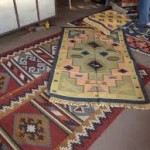 Durries were originally the poor cousins of carpets – meant purely as a utility product and lacked hugely in terms of finesse, design and ornamentation. Most often, they formed the bottom-most layer of the bedding or used as an underlay on the floor. For these reasons, they came in pedestrian designs and colours that tended to bleed.
Durries were originally the poor cousins of carpets – meant purely as a utility product and lacked hugely in terms of finesse, design and ornamentation. Most often, they formed the bottom-most layer of the bedding or used as an underlay on the floor. For these reasons, they came in pedestrian designs and colours that tended to bleed.
Interestingly, most of the skilled durry weavers were from areas that came to fall in present-day Pakistan and post the partition of India, they relocated to the North-Western regions of Rajasthan and Haryana. The handloom durry weavers in modern India faced stiff competition from the machine-made durries which flooded the market after 1947 and in order to survive the changing market dynamics, they began to experiment with colour and design. Today, colourful handloom durries are available in beautiful designs. However, one has to concede that the designs mostly limited to geometric or floral and the colours are earthy.
They are no longer poor cousins and find their way in many chic stores and homes which go for the eclectic, kitch look. Additionally, durries are durable, suitable for all seasons and rarely get infested with silverfish and other insects.
The durries made in Rajasthan, also known as Panja durries, are often found in cotton, camel hair and wool. They have steadily become one of the most popular weaving traditions of the state and command a sizable chunk of both the domestic and international market.
In fact, in Ranakpur, Rajasthan, the durry industry forms a huge part of the local economy and weavers even allow tourists into their workshops and share with them their skills. It would be a shame to miss out on these gorgeous works of craft.

Facebook comments: ManaHotels